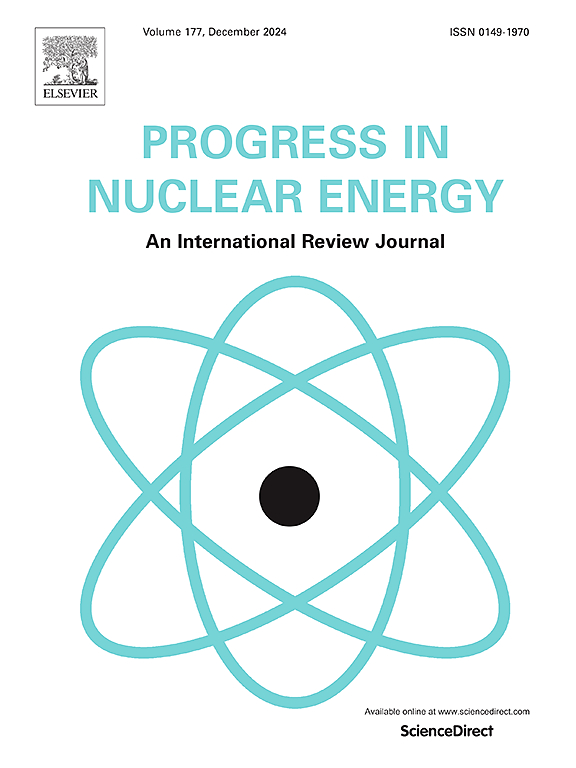排水钩对压水堆MSR波浪型叶片式蒸汽-水分离器性能影响的实验研究
IF 3.3
3区 工程技术
Q1 NUCLEAR SCIENCE & TECHNOLOGY
引用次数: 0
摘要
波浪型叶片从蒸汽-水混合物中提取液态水是压水堆水分离器再热器的关键工序,对减少水蚀损伤、提高水轮机相对内部效率,保证水轮机安全至关重要。此外,波浪型叶片的临界速度更高,在此速度下会发生再夹带,从而允许更小的MSR设备体积或具有显著的质量流量余量的设计。因此,水分携带量、压降和临界速度是MSR中波浪型叶片发展的主要重点参数。本文研究了基于同一主波型叶片的两种不同的排水钩结构。在MSR实际运行条件下,在干燥机模型上进行了波浪型叶片的汽水实验,以确定具有较好分离特性的排水挂钩结构。探讨了不同排水钩对分离特性的影响,对排水钩的带湿性、压降和临界流速进行了实验研究。在MSR操作条件下,波浪型叶片II在较大范围内具有较低的压降和较高的分离效率,是一种非常成功的推荐产品。本文章由计算机程序翻译,如有差异,请以英文原文为准。
Experimental study of the effect of drainage hooks on performance for wave-type vane separators of steam-water in PWR MSR
Extracting liquid water from the steam-water mixture by wave-type vanes is a key process in the moisture separator reheater (MSR) of pressurized water reactors (PWRs), which is essential to ensure turbine safety by reducing the water erosion damage and improve the relative internal efficiency of the turbine. Moreover, higher critical velocity of wave-type vanes, at which re-entrainment occurs, allows for smaller MSR equipment volume or a design with a significant margin for mass flow rate. Therefore, the moisture carryover, the pressure drop, and the critical velocity are the primary focus parameters in the development of wave-type vanes in MSR. In this work, two different drainage hook structures based on the same main wave-type vane were developed. Steam-water experiments with wave-type vanes in a dryer model under actual operating conditions for MSR were conducted to identify the drainage hook structure with the better separation characteristics. Experimental results on the moisture carryover, pressure drop, and the critical velocity were discussed to investigate the effect of different drainage hooks on separation characteristics. Under MSR operation conditions, the wave-type vane II exhibited lower pressure drop and higher separation efficiency across a broad range, making it a highly successful product recommended.
求助全文
通过发布文献求助,成功后即可免费获取论文全文。
去求助
来源期刊

Progress in Nuclear Energy
工程技术-核科学技术
CiteScore
5.30
自引率
14.80%
发文量
331
审稿时长
3.5 months
期刊介绍:
Progress in Nuclear Energy is an international review journal covering all aspects of nuclear science and engineering. In keeping with the maturity of nuclear power, articles on safety, siting and environmental problems are encouraged, as are those associated with economics and fuel management. However, basic physics and engineering will remain an important aspect of the editorial policy. Articles published are either of a review nature or present new material in more depth. They are aimed at researchers and technically-oriented managers working in the nuclear energy field.
Please note the following:
1) PNE seeks high quality research papers which are medium to long in length. Short research papers should be submitted to the journal Annals in Nuclear Energy.
2) PNE reserves the right to reject papers which are based solely on routine application of computer codes used to produce reactor designs or explain existing reactor phenomena. Such papers, although worthy, are best left as laboratory reports whereas Progress in Nuclear Energy seeks papers of originality, which are archival in nature, in the fields of mathematical and experimental nuclear technology, including fission, fusion (blanket physics, radiation damage), safety, materials aspects, economics, etc.
3) Review papers, which may occasionally be invited, are particularly sought by the journal in these fields.
 求助内容:
求助内容: 应助结果提醒方式:
应助结果提醒方式:


